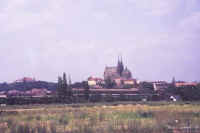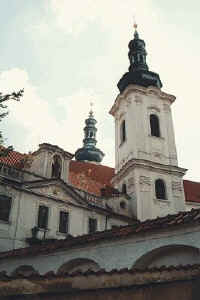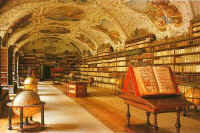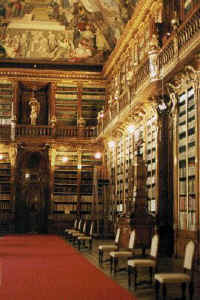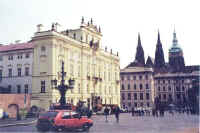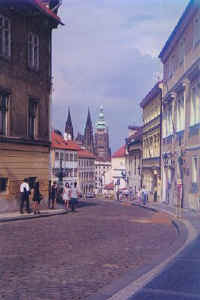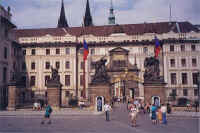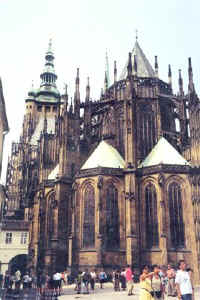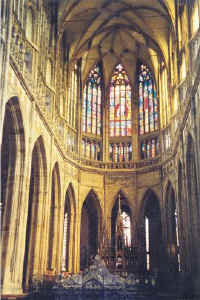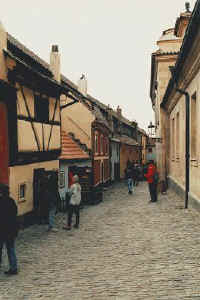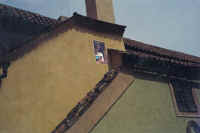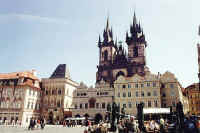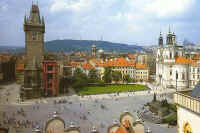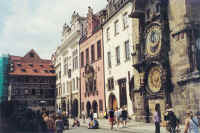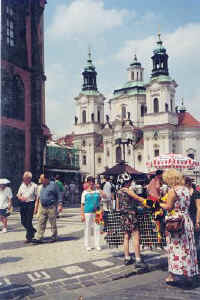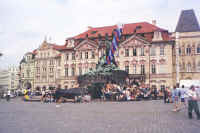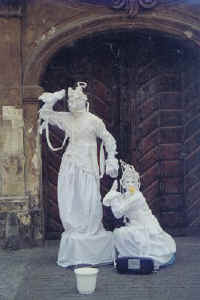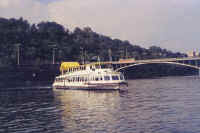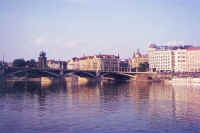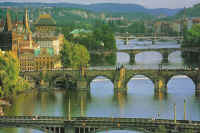|
Prague
Wednesday, 22 July: It was the now familiar routine for a travel day: a 6 a.m. wake up call, luggage in the hall
by 6:30, a quick breakfast, and on the bus by 8:00. There was also the usual delay crossing the border
from
Poland into the Czech Republic. Katie, knowing that it would be 2 p.m. before we got to Brno for lunch, not
only arranged a comfort stop for us along the way, but also bought each of us an ice cream
bar there. The Czech
currency is the koruna with an exchange rate of about 30 to the dollar.
Brno is the capital of Moravia, one of the three provinces that make up the Czech Republic. (The others are Bohemia and Silesia.) We didn't see much of Brno since our restaurant was not in the heart of the city. As we continued on in the bus, Katie passed around apple juice and her favorite buffalo grass vodka. We finally got to the Diplomat Hotel at 5:45 p.m. Although today had been cloudy and "only" in the low 80's, we were happy to find that this hotel really did have air conditioning. We met Katie at 6:45 for the customary orientation walk where she showed us the nearby subway stop and bank. We had a buffet dinner at seven, then sat around the dining room talking until almost 9:00. Thursday, 23 July: We woke up to another warm day. The breakfast buffet at the Diplomat was somewhat better than those in Poland. The bus left for the city tour at nine with a local guide who filled us in on Prague's history. Like Krakow, Prague is a very old city. It was founded in the 9th century and was the capital of Bohemia when that was an independent country. In the 14th century the city experienced unprecedented prosperity when the King of Bohemia became Holy Roman emperor as Charles IV and chose Prague as capital of the Empire (1355-1378). Although Bohemia lost its importance when it was absorbed into the Hapsburg's Austrian Empire in 1526, Prague had a resurgence when Emperor Rudolf II moved the capital there from Vienna (1576-1611). In 1918 the city became the capital of newly independent Czechoslovakia. Prague suffered little damage in World War II and has retained much of its original appearance, with narrow streets and many historic buildings in the Gothic and baroque styles. Many of the old palaces now house government offices and foreign embassies. The old center of Prague consists of five sectors. Old Town (Stare Mesto), New Town (Nove Mesto), and Josefov (former Jewish ghetto) are on the eastern bank of the river. On the western bank are the Lesser Quarter (Mala Strana) and Castle Hill (Hradcany). Our "city tour" by bus turned out to be more of a walking tour of Castle Hill. The bus took us to a point on the hill above the castle so we wouldn't have to walk uphill. From this point we had an excellent view, not only of the castle, but also of Old Town directly across the Vltava (Muldau) River. Our first stop on the tour was at the early 12th century Strahov Monastery. We saw the two main rooms of the library, Philosophy Hall and Theology Hall. They were strikingly beautiful. We also saw the monastery's ornate Church of St. Roch. As we walked down the narrow old streets, we stopped outside the Loreto of Prague, a 17th century Capuchin church. The name intrigued me because my Irish ancestors in Wisconsin attended a little church known as Our Lady of Loreto, and I had never heard that name before discovering that. However, there was no time to explore that now. As we approached Prague Castle we passed several palaces just outside of it, including Sternberk Palace, site of the National Gallery, and the Archbishop's Palace next door. There are several more palaces inside the castle. Prague Castle was the residence of Czech kings from the 10th century. The guide led us through Mathias Gate (1614), and we passed through two huge courtyards.
In the second was the modern-looking entrance to the offices of the President of the Republic. Entering the third courtyard, we came upon St. Vitus Cathedral, supposedly started by St. ("Good King") Wenceslas in the 10th century as a small chapel to house relics of St. Vitus. Our guide showed us the elaborate St. Wenceslas Chapel, one of the oldest parts of the present church, as well as the royal tombs.
We continued on to Golden Lane, a narrow street along the north castle wall. The name comes from the many alchemists who lived here in the late 16th century under Emperor Rudolph II, a great patron of science. Three centuries later, one of the tiny apartments (literally, a hole in the wall) was home to Franz Kafka. In a few minutes break from the tour, we visited a museum inside the wall. It contained mostly medieval armor, weapons, and clothes.
Moving down the third courtyard, we passed the old Royal Palace and faced St. George's Basilica and Convent. The foundations of the basilica date from the 10th century. [We revisited this area again on Saturday. See page 9 for pictures.] When the tour group reassembled, we all walked down Castle Hill, across Manesuv Bridge, and into Old Town Square, where we were turned loose. The picturesque square is surrounded by medieval buildings. Most prominent is the late 14th century Church of Our Lady before Tyn (sometimes called Tyn Church). Although the church faces and looms over the square, it is not on the square. It's lower portion is obscured by smaller buildings, and it's only entrance looks like part of the many shops lining the square. Across the square from the church is the old tower of the old town hall. (The old town hall itself was destroyed in World War II and the offices are now housed in what appear to be four distinct buildings adjoining the tower.) The tower is renowned for its astronomical clock (1490). As the clock strikes the hour, a window opens and each of the twelve apostles passes by, turns, and looks out. At the same time each of four figures on the outside of the clock moves in turn. The square in front of the clock is jammed with tourists at least 20 minutes before each hour. In the middle of the square is a large statue (1915) of John Huss, burned at the stake for heresy in 1415, but a Czech national hero. In and all around the square there were vendors either in stands under umbrellas or with push carts. I was intrigued by the large, comical hats (sold throughout the tourist area), but I couldn't figure out what I would do with it if I bought one. There were also the inevitable street musicians and mimes performing for tips. We had lunch (salads) at an Italian sidewalk cafe on the square. We were nearly finished when a German couple overtly began to covet our table. I invited them to join us, and we managed a little conversation in German. Walking down some of the streets off the square, we bought postcards and looked in the shops at Bohemian crystal, painted eggs, garnet jewelry, and whatever else was offered. Finally we caught the subway back to our hotel, arriving about 3:15 p.m. We cooled off and rested before getting ready for our evening dinner cruise on the Vltava River. The bus left at 5:30, taking us just across the Cechuv Bridge from Josefov (north of Old Town) where the river turns from north to east. We board a small boat that took us downstream through the heart of old Prague as we had a rather mediocre buffet dinner and were serenaded by strolling musicians. We passed through a lock below the Charles Bridge (1347), the oldest of the several bridges spanning the Vltava, and came to a "botel" moored in the river. Altogether, we passed under six bridges before our boat turned around and retraced its route, dropping us off about eight o'clock. The bus then drove us around so we could see some of the city by night. Our final stop was on a hill with a fine panorama of the city. We got back to the hotel about 8:40. Jane went up to the spa where she joined four Japanese women in the hot tub. From there she could see the St. Vitus Cathedral illuminated.
Copyright © 2000-2023 DarrellPeck.com All rights
reserved. | ||||||

